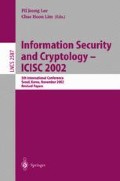Abstract
The power of sharing computation in a cryptosystem is crucial in several real-life applications of cryptography. Cryptographic primitives and tasks to which threshold cryptosystems have been applied include variants of digital signature, identification, public-key encryption and block ciphers etc. It is desirable to extend the domain of cryptographic primitives which threshold cryptography can be applied to. This paper studies threshold message authentication codes (threshold MACs). Threshold cryptosystems usually use algebraically homomorphic properties of the underlying cryptographic primitives. A typical approach to construct a threshold cryptographic scheme is to combine a (linear) secret sharing scheme with an algebraically homomorphic cryptographic primitive. The lack of algebraic properties of MACs rules out such an approach to share MACs. In this paper, we propose a method of obtaining a threshold MAC using a combinatorial approach. Our method is generic in the sense that it is applicable to any secure conventional MAC by making use of certain combinatorial objects, such as cover-free families and their variants. We discuss the issues of anonymity in threshold cryptography, a subject that has not been addressed previously in the literature in the field, and we show that there are trade-offis between the anonymity and efficiency of threshold MACs.
Access this chapter
Tax calculation will be finalised at checkout
Purchases are for personal use only
Preview
Unable to display preview. Download preview PDF.
References
M. Bellare, J. Kilian and P. Rogaway, The security of cipher block chaining: message authentication codes, Advances in Cryptology-Crypto’94, LNCs, 839 (1994), 340–358. (Also appeared in Journal of Computer and System Sciences Vol.61, No. 3, 2000, 362-399) 239, 241
M. Bellare, R. Guerin and P. Rogaway, XOR MACs: New methods for message authentication, Advances in Cryptology-Crypto’95, LNCs, 963 (1995), 15–28.
J. Black, Message authentication codes, PhD thesis, University of California, Davis, 2000.
S.R. Blackburn. Combinatorics and Threshold Cryptography, in Combinatorial Designs and their Applications, Chapman and Hall/CRC Research Notes in Mathematics, 403, F. C. Holroyd, K.A. S. Quinn, C. Rowley and B. S. Web (Eds.), CRCPress, London (1999) 49–70. 250
D. Boneh, G. Durfee and M. Franklin, Lower Bounds for Multicast Message Authentication, Advances in Cryptology-Eurocrypt’01, Lecture Notes in Comput. Sci.
C. Boyd, Digital multisignatures, Cryptography and coding (Beker and Piper eds.), Clarendon Press, 1989, 241–246. 238
E. Brickell, G. Di Crescenzo and Y. Frankel, Sharing Block Ciphers, Information Security and Privacy, Lecture Notes in Computer Science, ACISP2000, 2000. 239
Y. Desmedt, Society and group oriented cryptology: a new concept, Advances in Cryptography-CRYPTO’ 87, Lecture Notes in Comput. Sci. 293, 1988, 120–127. 238
Y. Desmedt, Y. Frankel and M. Yung, Multi-receiver/Multi-sender network security: efficient authenticated multicast/feedback, IEEE Infocom’92, (1992) 2045–2054. 239
M. van Dijk, C. Gehrmann and B. Smeets, Unconditionally Secure Group Authentication, Designs, Codes and Cryptography, 14( 1998), 281–296. 239
P. Erdös, P. Frankl, and Z. Furedi, Families of finite sets in which no set is covered by the union of r others, Israel Journal of Mathematics, 51(1985), 79–89. 246, 247
Y. Frankel, P. MacKenzie and M. Yung, Robust efficient distributed RSA-key generation, in Proc. 30th STOC, 663–672, ACM, 1998. 238
K. Martin and R. Safavi-Naini, Multisender Authentication Schemes with Unconditional Security, Information and Communications Security, LNCS, 1334 (1997), 130–143. 239
K. Martin, R. Safavi-Naini, H. Wang and P. Wild, Distributing the Encryption and Decryption of a Block Cipher. Preprint, 2002. 239, 244, 248, 250
S. Micali and R. Sidney. A Simple Method for Generating and Sharing Pseudo-Random Functions, with Applications to Clipper-like Escrow Systems. Advancesin Cryptology: CRYPTO’ 95, Lecture Notes in Computer Science, 963(1995), 185–195. 239, 244
A. Shamir, How to Share a Secret, Communications of the ACM, 22 (1976), 612–613. 245
V. Shoup, Practical Threshold Signature, Advances in Cryptology-Eurocrypt’99, LNCS, 1807(2000), 207–222. 238
G. J. Simmons, W.-A. Jackson and K. Martin. The Geometry of Shared Secret Schemes, Bulletin of the ICA, 1 (1991), 71–88.
D. R. Stinson, T. van Trung and R. Wei, Secure frameproof codes, key distribution patterns, group testing algorithms and related structures, J. Statist. Plan. Infer., 86(2000), 595–617. 247
D. S. Stinson, R. Wei and L. Zhu, Some new bounds for cover-free families, Journal of Combinatorial Theory, A, 90(2000), 224–234. 247
Author information
Authors and Affiliations
Editor information
Editors and Affiliations
Rights and permissions
Copyright information
© 2003 Springer-Verlag Berlin Heidelberg
About this paper
Cite this paper
Martin, K.M., Pieprzyk, J., Safavi-Naini, R., Wang, H., Wild, P.R. (2003). Threshold MACs. In: Lee, P.J., Lim, C.H. (eds) Information Security and Cryptology — ICISC 2002. ICISC 2002. Lecture Notes in Computer Science, vol 2587. Springer, Berlin, Heidelberg. https://doi.org/10.1007/3-540-36552-4_17
Download citation
DOI: https://doi.org/10.1007/3-540-36552-4_17
Published:
Publisher Name: Springer, Berlin, Heidelberg
Print ISBN: 978-3-540-00716-6
Online ISBN: 978-3-540-36552-5
eBook Packages: Springer Book Archive

